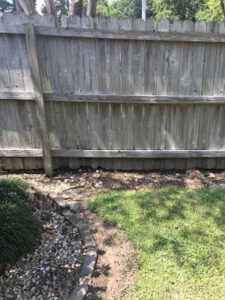Cleaning Exterior Wood Surfaces

As wood ages, mildew (mold) and algae begin to grow on the surface. This is a normal process; these organisms do not degrade the wood. They cannot break down the structural components of wood. They just live there. They feed off airborne contaminants, extractives, and oils in wood and in some finishes. Algae and molds can be cleaned quite easily and effectively with bleaching agents such as sodium hypochlorite (liquid household bleach) and sodium percarbonate (the active ingredient in some commercial cleaners). Bleaching agents quickly kill mold and algae, but they also can degrade wood. Therefore, mix cleaners as dilutely as possible. The object is to remove the fungi without excessive wood damage.
Most experts recommend using commercial cleaners containing sodium percarbonate or other oxygen bleaches because they are more gentle oxidizers than chlorine-containing bleaches such as household bleach. Chlorine bleaches tend to cause excessive pulping of the wood to give a fuzzy surface. However, some commercial cleaners contain strong alkali (sodium hydroxide or potassium hydroxide). These ingredients help to remove residual finishes on the wood surface, but can cause even more surface damage than chlorine bleach. The photo below shows a person cleaning a deck with oxygen bleach and a gentle brush. These same techniques can be used to clean shingles and siding.

(Photo Courtesy of US Forest Products Lab)
When using a cleaner, you might mix the solution weaker than the recommended strength and try it on a small area. If the weaker solution doesn’t work, increase the concentration until you find a concentration that cleans the wood. A fuzzy surface appearance or excessive removal of surface fibers indicates that the solution concentration is too strong. Apply cleaning solutions with a garden-type sprayer, sponge mop, or soft bristle brush and keep the surface wet with the cleaning solution for 12 to 15 minutes. It is best to work on a cool cloudy day or even during a gentle rain so the solution doesn’t evaporate. Aggressive scrubbing shouldn’t be necessary; let the cleaner do the work. Rinse with a garden hose keeping the water-stream pointed down. High pressure shouldn’t be necessary. You do not need a pressure washer! Allow the surface to dry for several days before refinishing.
We recommended using commercial cleaners, but if you prefer to use liquid household bleach, start with a cleaning solution of about five parts warm water mixed with one part bleach) with a small amount of powdered detergent. Do not use detergent that contains ammonia. Ammonia reacts with bleach to form toxic fumes. If the surface mildew is difficult to remove, you should then work with a stronger solution of three or four parts water added to one part bleach and detergent. It should not be necessary to use a concentration stronger than three to one.
If the dilute cleaning solutions described above are not effective, it is probably because the mildew is inter-grown with residual finish on the surface. The residual finish is keeping the cleaning solution away from the mildew. In this situation, it may be necessary to use more aggressive cleaning methods, such as the cleaners containing strong alkali. In some cases, use a paint stripper to remove the residual finish prior to cleaning.
As with unfinished wood, wood finished with wood repellant preservatives (WRPs) and semitransparent stains degrades as these finishes degrade. Ultraviolet radiation in sunlight degrades lignin at the surface. Lignin is the natural glue in wood that holds the cellulose fibers in place. Degradation of lignin weakens the surface fibers, and strong cleaning solutions and aggressive methods will remove excessive amounts of fiber from the surface. Removing these fibers is detrimental to the performance of subsequent application of WRPs or semitransparent stains. These finishes perform best by penetrating the wood surface and as a wood surface degrades, it becomes more porous. If excessive amounts of fiber are removed during cleaning, the surface will not accept these finishes as well as the porous weathered surface. Again, when cleaning wood, the gentler the better.
Iron reacts with the extractives in cedar redwood to give a dark blue-black stain. This often occurs when the zinc on galvanized fasteners weathers away or from rust washed from other sources such as window screens, failed flashing, or metal ornaments. This blue-black stain can be neutralized with a 5% solution of oxalic acid (usually available at drugstores).
Note: Oxalic acid is toxic. Many commercial wood cleaners contain oxalic acid. Oxalic acid will neutralize the iron stains and will also remove extractive stains. Oxalic acid generally brightens the wood surface, but is not very effective for removing algae or mold, nor will it keep iron stain from reoccurring if the source of the iron is not removed.
Note: This article was reproduced from a previous post by the US Forest Products Laboratory.
For more information, please read Causes and Control of Wood Decay, Degradation, and Stain.
Todd Shupe is the President of Wood Science Consulting, LLC. He is a a well-recognized expert on wood preservation, insects and fungi, wood decay and degradation, and wood species identification. He has a broad background in new product development, quality management, and marketing and sales in both the public and private sectors. For more information please visit DrToddShupe.com.

